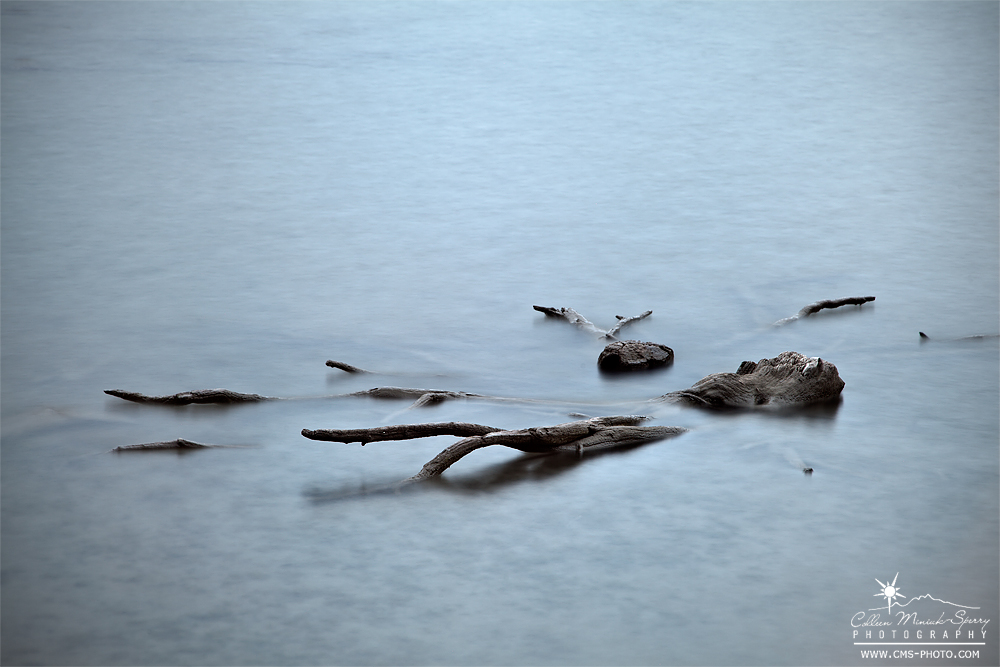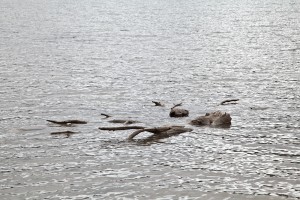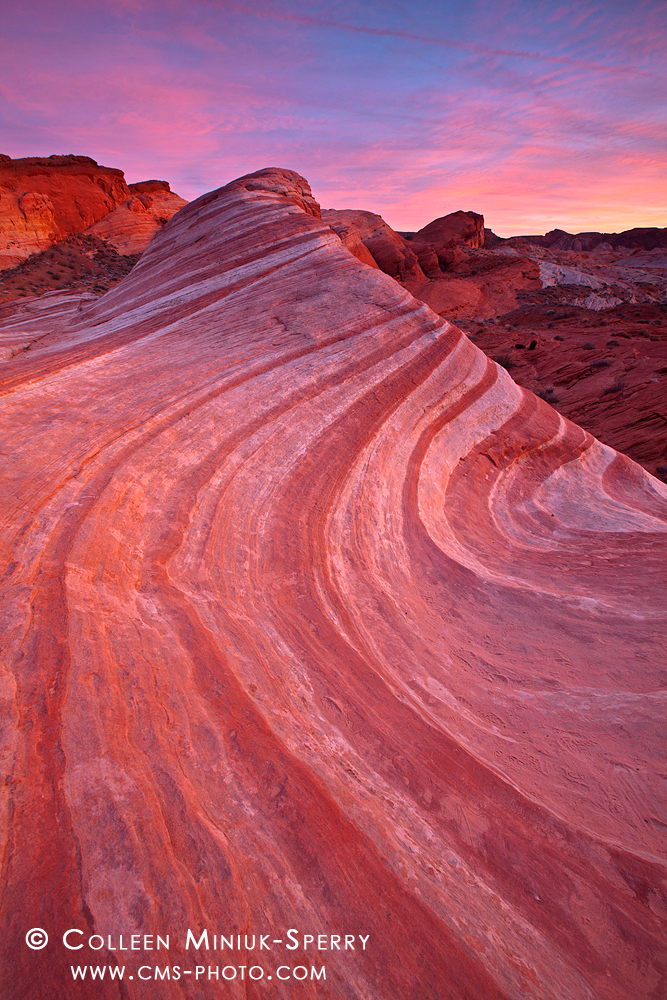
“Fire Away,” Valley of Fire State Park, NV. The iconic Fire Wave rock formation at sunset in the Valley of Fire State Park. (Prints available for purchase – click on photo to order!)
Although it wasn’t completely obvious, hopefully you’ve realized my blog post yesterday, “Making the Image: My Most Unique Photo of Yosemite” was part of a semi-elaborate April Fool’s Day joke, where 11 participating photographers posted the exact same image of Tunnel View (the idea and image compliments of Jim Goldstein). We linked our blogs together, suggesting we all shared tripod holes to get our “most unique shot of Yosemite.” We really didn’t go to Tunnel View.
If you haven’t done so already, the hilarious faux write-ups alone are worth clicking through the chain of linked blog posts:
Jim Goldstein: www.jmg-galleries.com/blog/2015/04/01/my-most-unique-photo-yosemite/
Colleen Miniuk-Sperry: youcansleepwhenyouredead.com/wordpress/making-the-image-my-most-unique-photo-of-yosemite/
Olivier Du Tre: blog.olivierdutre.com/2015/04/tunnel-view.html
Ken Cravillion: kgcphoto.blogspot.ca/2015/04/original-tunnel-view.html
David Leland Hyde: landscapephotographyblogger.com/my-most-unique-photograph-of-yosemite-valley/
Jim Sabiston: www.essentiallight.blogspot.com/2015/04/my-most-unique-photo-of-yosemite-yet.html
Eric Fredine: www.ericfredine.ca/blog/2015/3/31/my-unique-take-on-yosemite
Floris van Breugel: www.artinnaturephotography.com/wordpress/2015/fresh-air-and-fresh-views/
Richard Wong: www.rwongphoto.com/blog/my-most-unique-photo-of-yosemite-yet/
Youssef Ismail: www.organiclightphoto.com/blog/?p=1918
Gary Crabbe: www.enlightphoto.com/views/2015/04/01/best-yosemite-shot-ever.htm
The silly prank aimed to highlight and poke fun at the inundation of homogeneity we see in nature photography today. Endless streams of the same scene in magazines, calendars, postcards, Flickr, and social media could easily lead us to believe those are the only subjects worth photographing. To this point, I made a sarcastic comment in yesterday’s post, “…but I figured if Ansel hadn’t found something gorgeous to shoot in those spots, I sure wasn’t going to!” With the highest respect for Mr. Adams, this notion is absurd.
Early in my photography career, I spent a lot of time blasting away at classic scenes for three reasons. One, I wanted to see these amazingly beautiful scenes with my own eyes (and not solely through others’ photographic interpretations). Two, the predefined compositions gave me a baseline to determine how well I was controlling my camera to get expected results. And three, they sold well (hence the “endless streams of the same scene in magazines, calendars, and postcards”).
In hindsight, a fourth reason existed: I knew how to look; I did not know how to see. After eventually getting bored with having my photographs look like everyone else’s, I turned to learn more creative ways of expressing my personal vision. As I did – and continue to do – so, the question remains, “Can I shoot the icons?” Or better yet, “Can I shoot the icons and still be called a respectable photographer?” As I wandered around the Valley of Fire State Park in Nevada (not Oregon, as my April Fool’s blog suggested) in mid-February after proofing my book, the answer came to light.
I had visited the park before, but never photographed during what I considered conducive lighting conditions. Normally, I would research and visualize before setting out to a location. However, I could only find 24 hours a day in the days leading up to my trip, and preparing the book for printing consumed most (if not all) of that time. As a result, my brain only recalled two locations based on what I had seen on the internet: the Fire Wave and Elephant Arch.
During my six-hour trek, I initially decided to avoid these two iconic spots in the park. Although I did not have copies of either scene in my stock files, I wondered how could I possibly showcase these two sites differently all the previous photographers, hikers, and general nature enthusiasts alike who had already snapped their own photos here.
Making a pretty photograph of a roadkill (meaning: easily accessed), classic scenes – the Fire Wave, Elephant Arch, and other icons like Delicate Arch in Arches National Park or Tunnel View in Yosemite National Park – is easy. Mother Nature has already painted the beautiful palette and thousands (if not millions) of photographers have already figured out (and proven by mimicking excessively) essentially the same composition. ‘All’ one needs to do is show up at these places, turn your camera on, and wait for a vibrant multi-hued sky; a double rainbow; or a glowing Milky Way overhead.
But simply incorporating fleeting light into a cliché composition is a bit like putting lipstick on a pig. Changing the weather conditions does not transform a documentary “trophy” shot into something fresh or creative.
Then a different thought crossed my mind: Why should the fact that every photographer but me has photographed these scenes prevent me from enjoying and photographing them for myself? Stubbornly, I decided it should not, and so I changed my mind as I crossed into Nevada. I resolved to photograph the Fire Wave later that evening.
I arrived about two hours before sunset to scope out the Fire Wave area. I held two attitudes about the evening: one, I would likely share the location with other photographers wishing to make their own images – and that’s OK! – and two, tourists wishing to snap selfie’s while standing atop the rock formation had equal right to enjoy the scene as I did. Under no circumstance would I pretend I owned the place or tell anyone to get out of the way (two things I have watched with great sadness by impolite and impatient photographers at iconic locations before). After all, they made the clone-stamp and patch tools in Photoshop for a reason, right? Right.
Much to my surprise, only two other photographers scampered about the rocks (one of whom left well before the sun went down). I tested a variety of compositions with my wide-angle lens and four-stop graduated neutral density filter, settled into my favorite position, and then waited. Thanks to the candy-colored light show Mother Nature provided, I brought home a nice rendition of an iconic shot for my stock files (photo above).
Following a rejuvenating restful sleep, the next morning, I pulled into one of the parking lots, flipped my camera gear onto my back, and melted into the shadowed canyonlands with no particular destination in mind. Unlike shooting pre-existing compositions, creative photography requires a more mindful, peaceful, slower pace – one where experiencing, discovering, and connecting with my surroundings occurs before making an image (if an image is made at all). I philosophically agree with Ansel Adams’ perspective, “My photographs become records of experiences as well as places.”
I eventually picked up the White Domes Slot Canyon Trail where I spent two hours in awe (and 129 different compositions) hovering over a small wash where I created my “Stone Butterfly” – an apropos composition that revealed I was ready for a metamorphoses from cliché images to creating my own here. (Post continues after photograph)
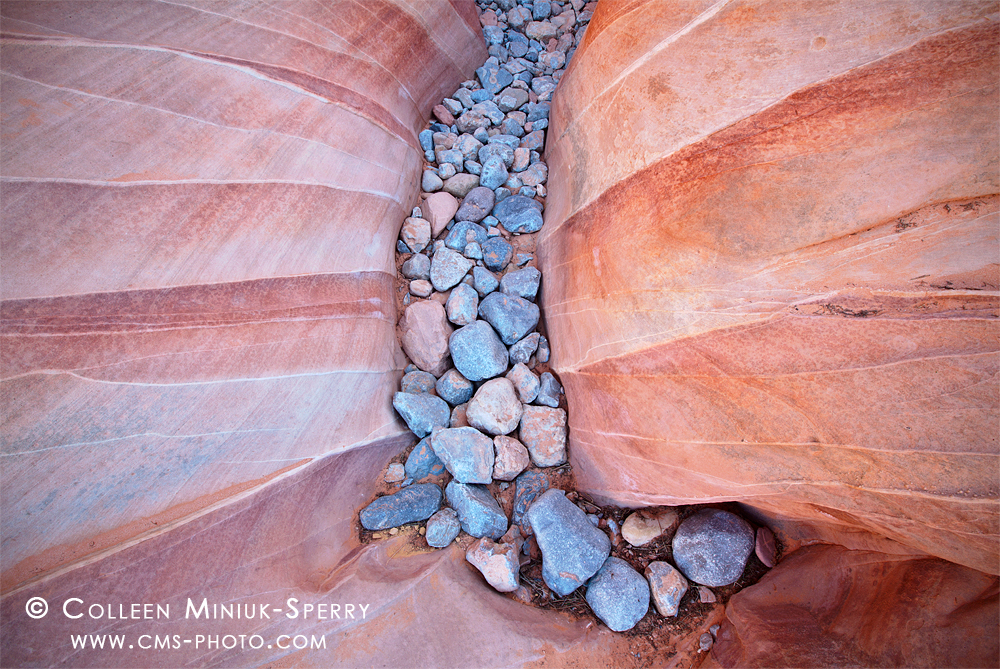
“The Stone Butterfly,” Valley of Fire State Park, Nevada (Prints available for purchase – click on photo to order!)
For the remainder of my three-day stay, I continued to wander through unnamed canyons and rock shelves to create fresh footprints in the sand and to soak in this magically whimsical environment in my own way.
I longed to see a hypothetical time-lapse video showing the seemingly impossible process of these sherbet colored rocks forming eons ago. (Post continues after photograph)
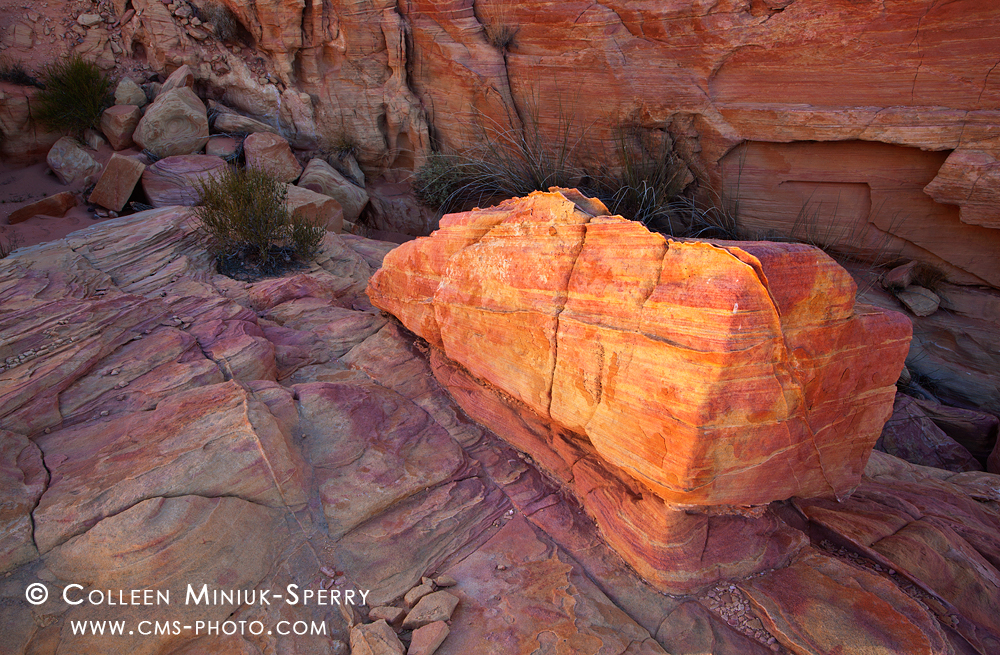
“Diamond in the Rough,” Valley of Fire State Park, NV (Prints available for purchase – click on photo to order!)
I marveled at the stars visible from my campsite while sipping wine. (Post continues after photograph)
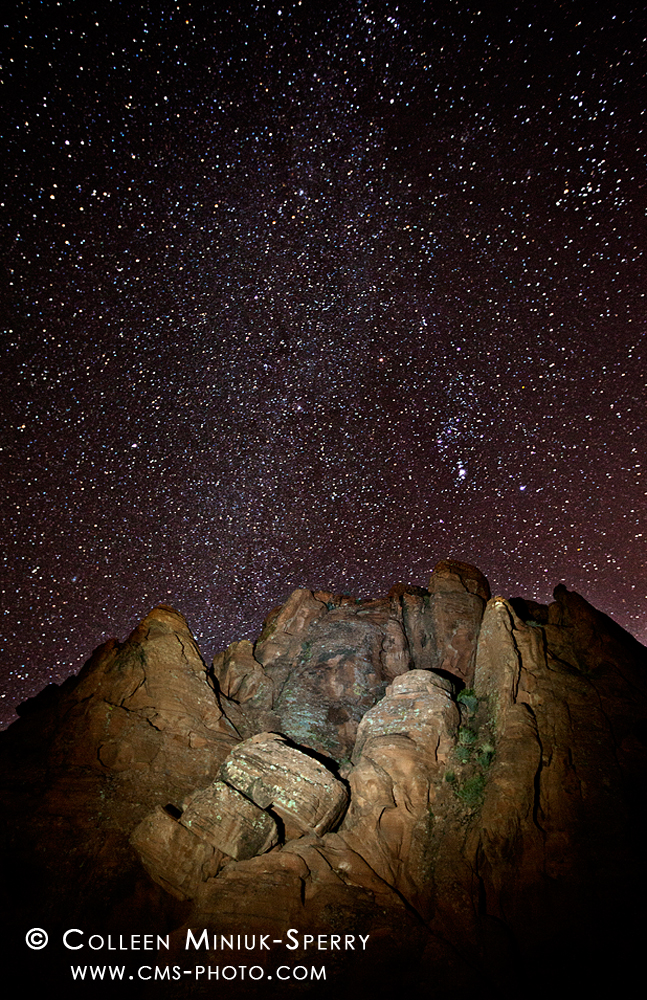
“The Gathering,” Valley of Fire State Park, NV (Prints available for purchase – click on photo to order)
I paid homage to Anubis, an Egyptian reference found in the Elizabeth Peters book I had just finished reading the night before. (Post continues after photograph)
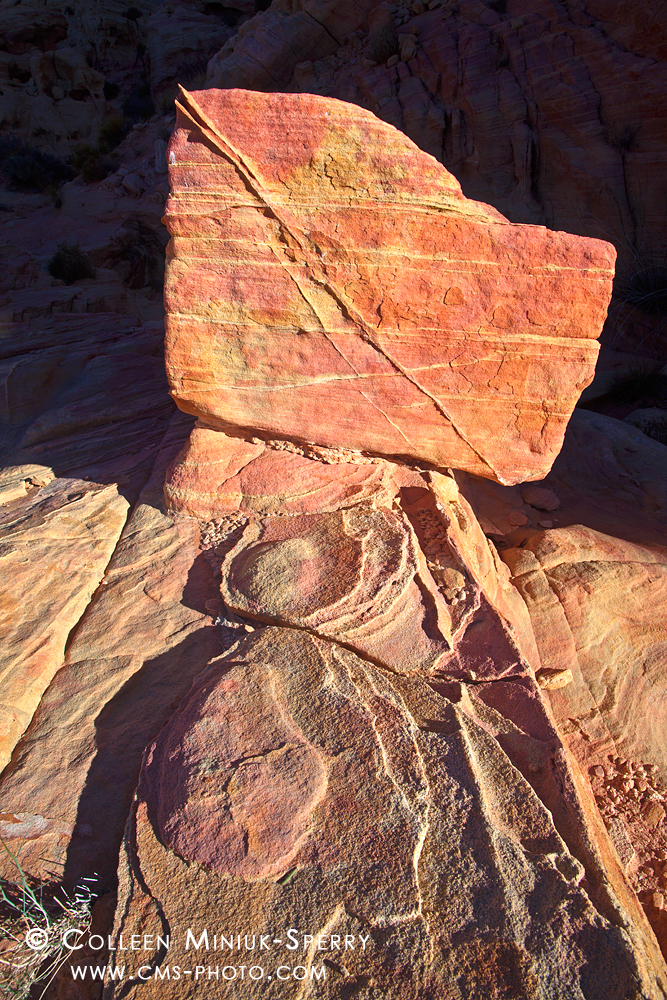
“Anubis in Stone,” Valley of Fire State Park, NV (Prints available for purchase – click on photo to order)
I broke down crying in front of a dead tree for a dear friend who had passed away unexpectedly just two weeks before my trip. (Post continues after photograph)
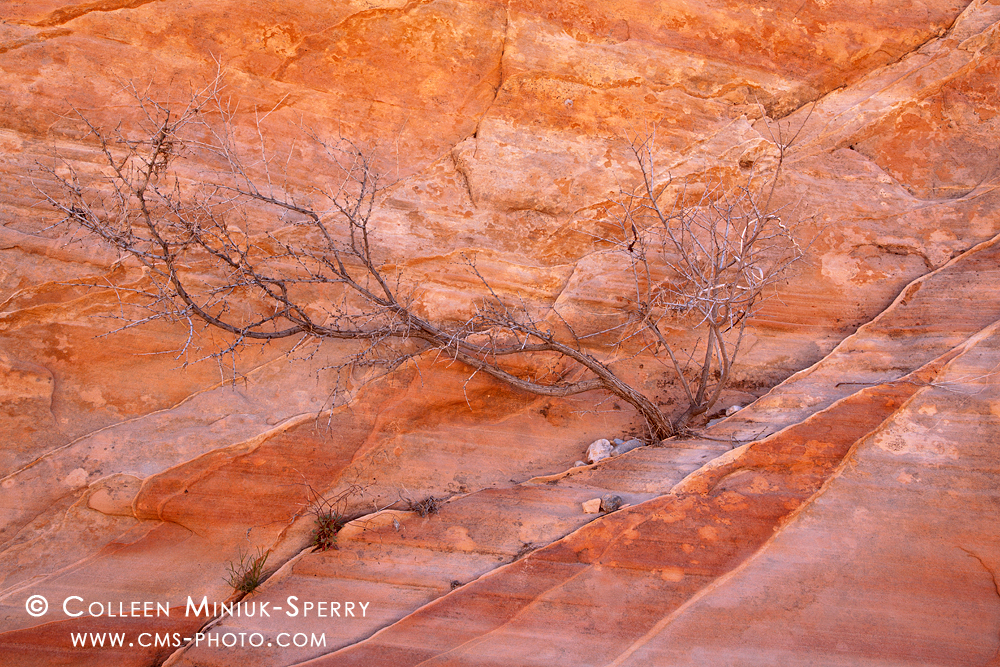
“Gone, But Not Forgotten (In Memory of Jim),” Valley of Fire State Park, NV (Prints available for purchase – click on photo to order)
In each of these meaningful moment, I made an image to represent my experience in this fantastical place.
On the final morning of my stay, when I needed to quickly return to my Arizona, I determined the easiest and quickest location to photograph on the way out was – wait for it – the roadside Elephant Arch. I approached the icon just as the red “sailors heed warning” colored sky transformed the orange sandstone in all directions into a glowing ember-like spectacle. The light unfolding over the landscape opposite the arch spoke to me. (Post continues after photograph)
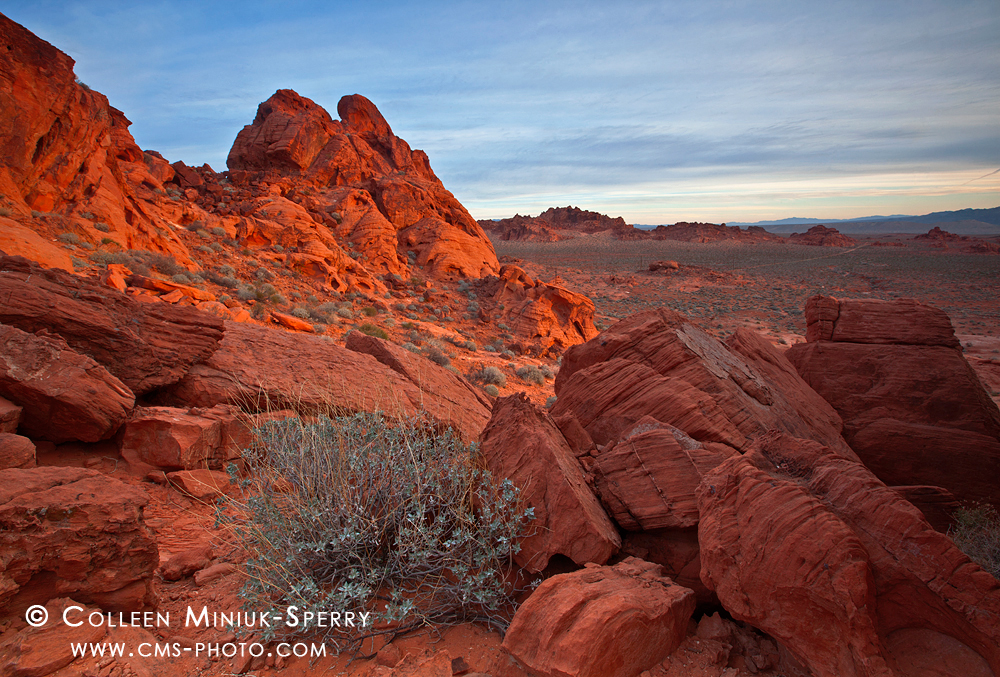
“A True Valley of Fire,” Valley of Fire State Park, NV (Prints available for purchase – click on photo to order)
As I made my final image (of a scene some may overlook while honing in on Elephant Arch), I thought to myself, can I shoot the icons (and still be called a respectable photographer? Sure. Because of their remarkable beauty, anyone who wishes to do so, should. Just don’t expect to be alone or different as you do so.
Without question, though, I would encourage everyone with even greater enthusiasm to look beyond them for your own artistic expressions. Tremendously more rewarding and fulfilling moments await if you are willing to uniquely experience the world around you and focus on photographing the meaningful connections you develop along your own journey.
Happy trails,
Colleen
P.S. To see all 13 images I created during my three-day trip, visit http://cms-photo.photoshelter.com/gallery/Nevada/G00002EqYTMEHKIE/C0000.fuI6BhfIuI.
P.P.S. To gain an abundance of insight about “Personalizing Place” from a variety of different photographers/speakers, join us at the upcoming Moab Photo Symposium on May 1-3, 2015. Learn more at moabphotosym.com.
